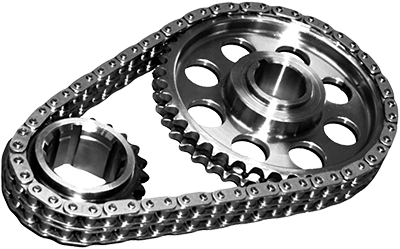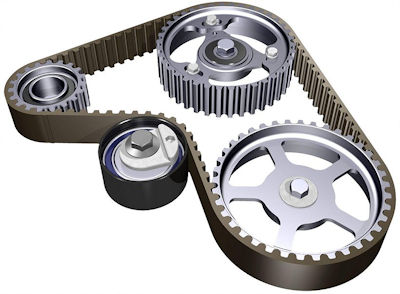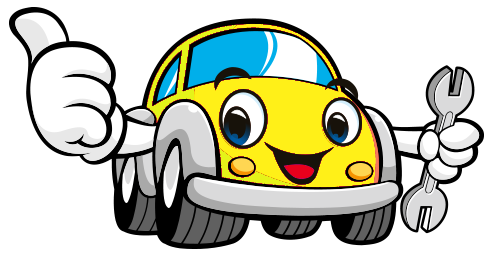


Mobile users:
For best results, view in Landscape mode.

A timing belt or chain can be found
inside your engine.
A timing belt or timing chain is a part of an internal combustion engine
that synchronizes the rotation of the crankshaft so that the engine's
valves open and close at the proper times during each cylinder's intake
and exhaust strokes.
Timing chains were common in the 1970's and 1980's, but then timing
belts took over.
Timing chains have seen a resurgence in recent years as they are more
durable than timing belts.
Timing chains are made up of a series of links, just like you see on a
bicycle chain.
There are toothed sprockets at the ends of the crankshaft and camshaft
and the links locate into these.
As the chain moves, it opens the valves and moves the pistons which are
connected to the rods in the combustion chamber.
If your car's engine has a timing chain and the oil is changed on a regularly,
the timing chain should last 100,000 miles or more unless there
is a specific problem.
A timing chain is more durable and rarely breaks, but can start to stretch
and wear over time.
Timing chains don't need to be replaced as often as timing belts, but they
are more expensive to replace.
Problems with the timing chain are common in higher mileage vehicles.
If the timing chain breaks as you are driving, the engine will stop and you
will break down.
If your car is parked up at your home and the chain is broke, the engine
won’t be able to compress enough air to get it started.
The best way to prevent timing chain failure is to have
the tensioner checked.
Signs of a Failing Timing Chain:
The Check Engine Light is on.
When the timing chain is stretched, it makes the engine perform
poorly and so the engine emissions are increased.
This triggers the engine light to come on.
The engine misfires.
A misfire occurs when something in the sequence fails.
Most engines have 4-cylinders so the car will keep running even
if one cylinder stops working just not at its full potential.
The engine has a rough idle and a rattling or scrapping sound.
Metal shavings are found in the oil.
If the timing chain begins to wear out, small metal pieces can
break off the chain, and find their way into the oil pan.
When you have your oil changed, and your mechanic tells
you that there were small pieces of metal inside the oil as it drained
or in the filter, it's a good indication that your timing chain is
beginning to fail.
Timing belts need to be changed every 5 years or 30,000 - 60,000 miles
or more, depending upon the make of your vehicle.
The timing belt is a rubber belt that turns and synchronizes the
camshaft and crankshaft.
The timing belt also keeps the valves and pistons moving and in
sync with each other.
The valves push the pistons down when the fuel is ignited.
Without the timing belt, the valves don’t open and close to allow the
fuel to ignite and the car doesn’t run.
The timing belt can also drive the oil or water pump depending on
engine type.
It's recommended to replace the water pump at the same time that
the timing belt is replaced.
Timing belts also have tensioners that keep your timing belt tight
and in line.
It's recommended to replace the tensioners and pulleys whenever
you replace your timing belt.
Pulleys cannot be lubricated often, therefore the bearings contained
in the unit can wear out.
This will cause the timing belt to fall off and cause expensive engine
damage.
A sign is a high-pitched squealing sound whenever the engine is
running.
This sound is unmistakable and can be hard to miss because it
continues as long as the engine is running.
The timing belt that’s in need of service or replacement will squeal
at a different pitch than brakes that squeal will occur when brakes
aren’t being applied.
Other signs that you have a bad timing belt:
Teeth are worn down,
Teeth are hollowed out,
Back of belt is cracked,
Edges of belt are worn,
Belt is soaked with oil
Check your owner's manual if you aren't sure how to access and
check the timing belt. Or ask your mechanic to check the belt
periodically for you.
If the timing belt is coated in oil or see any cracks, worn out teeth,
or stretching, it should be replaced.
Replacing a timing belt requires a intense level of skill, and accessing
the timing belt usually involves removing several of the
accessories that are attached to the engine in the area of the belt.
So you should have your mechanic replace it for you.
If you don’t know whether your vehicle has a timing belt or chain,
check your owner’s manual.


